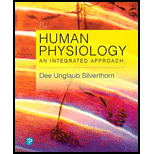
Human Physiology: An Integrated Approach (8th Edition)
8th Edition
ISBN: 9780134605197
Author: Dee Unglaub Silverthorn
Publisher: PEARSON
expand_more
expand_more
format_list_bulleted
Question
Chapter 23.5, Problem 13CC
Summary Introduction
To determine: The reason for the fact that adults with growth hormone hypersecretion do not grow taller.
Introduction: Bone is connective tissue, and it forms the synthesis of the osteoblasts. During the resorption of the bones, the calcified matrix is dissolved by the acids which are secreted by osteoblasts.
Expert Solution & Answer
Want to see the full answer?
Check out a sample textbook solution
Students have asked these similar questions
Please draw in the missing answer, thank you
Please fill in all blank questions, Thank you
please fill in missing parts , thank you
Chapter 23 Solutions
Human Physiology: An Integrated Approach (8th Edition)
Ch. 23.2 - Prob. 1CCCh. 23.2 - Prob. 2CCCh. 23.2 - What do the abbreviations HPA and CBG stand for?...Ch. 23.2 - Prob. 4CCCh. 23.2 - Prob. 5CCCh. 23.2 - Prob. 6CCCh. 23.2 - Would someone with Addisons disease have normal,...Ch. 23.2 - Prob. 8CCCh. 23.3 - A woman who had her thyroid gland removed because...Ch. 23.3 - Prob. 10CC
Ch. 23.4 - Prob. 11CCCh. 23.5 - Prob. 12CCCh. 23.5 - Prob. 13CCCh. 23.6 - Prob. 14CCCh. 23.6 - Prob. 15CCCh. 23.6 - Prob. 16CCCh. 23.6 - Prob. 17CCCh. 23 - Name the zones of the adrenal cortex and the...Ch. 23 - For (a) cortisol, (b) growth hormone, (c)...Ch. 23 - Prob. 3RQCh. 23 - Prob. 4RQCh. 23 - Define each of the following terms and explain its...Ch. 23 - Prob. 6RQCh. 23 - Prob. 7RQCh. 23 - Prob. 8RQCh. 23 - Define, compare, and contrast or relate the terms...Ch. 23 - Prob. 10RQCh. 23 - Prob. 11RQCh. 23 - Osteoclasts make acid (H+) from CO2 and H2O. They...Ch. 23 - Prob. 13RQCh. 23 - One diagnostic test to determine the cause of...Ch. 23 - Prob. 15RQCh. 23 - Prob. 16RQCh. 23 - Prob. 17RQCh. 23 - Prob. 18RQCh. 23 - Prob. 19RQ
Knowledge Booster
Learn more about
Need a deep-dive on the concept behind this application? Look no further. Learn more about this topic, biology and related others by exploring similar questions and additional content below.Similar questions
- please draw in the answers, thank youarrow_forwarda. On this first grid, assume that the DNA and RNA templates are read left to right. DNA DNA mRNA codon tRNA anticodon polypeptide _strand strand C с A T G A U G C A TRP b. Now do this AGAIN assuming that the DNA and RNA templates are read right to left. DNA DNA strand strand C mRNA codon tRNA anticodon polypeptide 0 A T G A U G с A TRParrow_forwardplease answer all question below with the following answer choice, thank you!arrow_forward
- please draw in the answeres, thank youarrow_forwardA) What is being shown here?B) What is indicated by the RED arrow?C) What is indicated by the BLUE arrow?arrow_forwardPlease identify the curve shown below. What does this curve represent? Please identify A, B, C, D, and E (the orange oval). What is occurring in these regions?arrow_forward
- Please identify the test shown here. 1) What is the test? 2) What does the test indicate? How is it performed? What is CX? 3) Why might the test be performed in a clinical setting? GEN CZ CX CPZ PTZ CACarrow_forwardDetermine how much ATP would a cell produce when using fermentation of a 50 mM glucose solution?arrow_forwardDetermine how much ATP would a cell produce when using aerobic respiration of a 7 mM glucose solution?arrow_forward
- Determine how much ATP would a cell produce when using aerobic respiration to degrade one small protein molecule into 12 molecules of malic acid, how many ATP would that cell make? Malic acid is an intermediate in the Krebs cycle. Assume there is no other carbon source and no acetyl-CoA.arrow_forwardIdentify each of the major endocrine glandsarrow_forwardCome up with a few questions and answers for umbrella species, keystone species, redunant species, and aquatic keystone speciesarrow_forward
arrow_back_ios
SEE MORE QUESTIONS
arrow_forward_ios
Recommended textbooks for you
 Human Physiology: From Cells to Systems (MindTap ...BiologyISBN:9781285866932Author:Lauralee SherwoodPublisher:Cengage Learning
Human Physiology: From Cells to Systems (MindTap ...BiologyISBN:9781285866932Author:Lauralee SherwoodPublisher:Cengage Learning Human Biology (MindTap Course List)BiologyISBN:9781305112100Author:Cecie Starr, Beverly McMillanPublisher:Cengage LearningEssentials of Pharmacology for Health ProfessionsNursingISBN:9781305441620Author:WOODROWPublisher:Cengage
Human Biology (MindTap Course List)BiologyISBN:9781305112100Author:Cecie Starr, Beverly McMillanPublisher:Cengage LearningEssentials of Pharmacology for Health ProfessionsNursingISBN:9781305441620Author:WOODROWPublisher:Cengage
 Biology 2eBiologyISBN:9781947172517Author:Matthew Douglas, Jung Choi, Mary Ann ClarkPublisher:OpenStax
Biology 2eBiologyISBN:9781947172517Author:Matthew Douglas, Jung Choi, Mary Ann ClarkPublisher:OpenStax Anatomy & PhysiologyBiologyISBN:9781938168130Author:Kelly A. Young, James A. Wise, Peter DeSaix, Dean H. Kruse, Brandon Poe, Eddie Johnson, Jody E. Johnson, Oksana Korol, J. Gordon Betts, Mark WomblePublisher:OpenStax College
Anatomy & PhysiologyBiologyISBN:9781938168130Author:Kelly A. Young, James A. Wise, Peter DeSaix, Dean H. Kruse, Brandon Poe, Eddie Johnson, Jody E. Johnson, Oksana Korol, J. Gordon Betts, Mark WomblePublisher:OpenStax College

Human Physiology: From Cells to Systems (MindTap ...
Biology
ISBN:9781285866932
Author:Lauralee Sherwood
Publisher:Cengage Learning

Human Biology (MindTap Course List)
Biology
ISBN:9781305112100
Author:Cecie Starr, Beverly McMillan
Publisher:Cengage Learning

Essentials of Pharmacology for Health Professions
Nursing
ISBN:9781305441620
Author:WOODROW
Publisher:Cengage


Biology 2e
Biology
ISBN:9781947172517
Author:Matthew Douglas, Jung Choi, Mary Ann Clark
Publisher:OpenStax

Anatomy & Physiology
Biology
ISBN:9781938168130
Author:Kelly A. Young, James A. Wise, Peter DeSaix, Dean H. Kruse, Brandon Poe, Eddie Johnson, Jody E. Johnson, Oksana Korol, J. Gordon Betts, Mark Womble
Publisher:OpenStax College
Great Glands - Your Endocrine System: CrashCourse Biology #33; Author: CrashCourse;https://www.youtube.com/watch?v=WVrlHH14q3o;License: Standard Youtube License